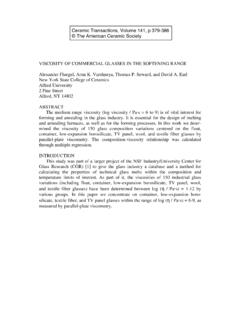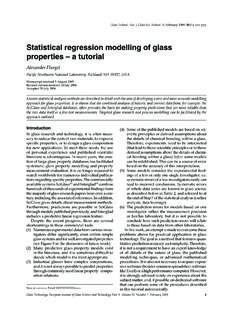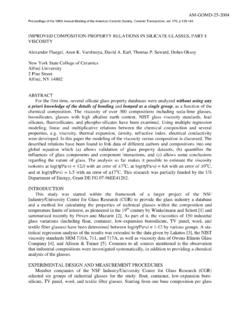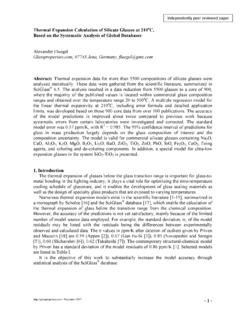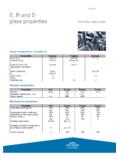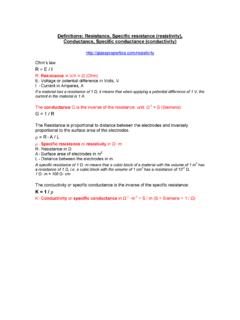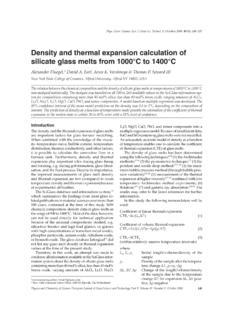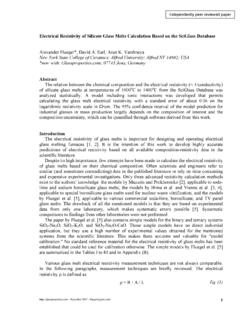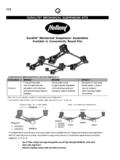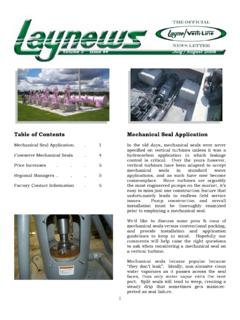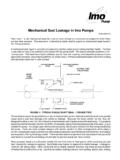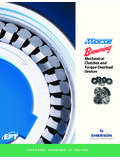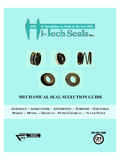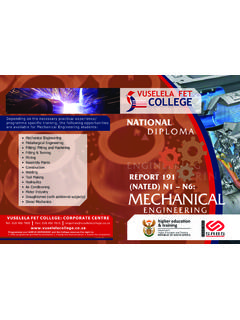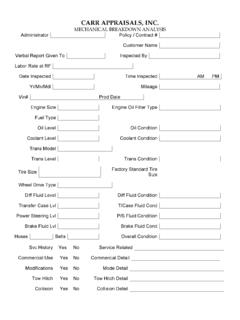Transcription of The Mechanical Properties of Glass
1 Introduction to Glass Technology1 The Mechanical Properties of GlassTheoretical strength, practical strength, fatigue, flaws, toughness, chemical processesGlass Engineering150:312 Professor Richard LehmanDepartment of Ceramics and Materials EngineeringRutgers University, New Brunswick, New Jersey, USAS pecific Strength and Stiffness of Selected Bulk [specific strength]E/p [spe cific stiffne ss]TitaniuMagnesiumAluminum 2014-T6 SteelSteel, hot rolled, 1% CMagnesiumSteelTitaniuGlassGlass, Chem TemperedGlass, Phys. TemperedAluminum, 1100-H14 Introduction to Glass Technology2 Most glasses have strong covalent bonds Si-O bonds, 435 kJ/mole Yields theoretical strength of 17 GPa Practical strength is much less Depends on flaws, usually on surface9scratches9bubbles9inhomogeneitie s9inclusions9any mechanically distinguishable phase Manufactured Glass has nominal strength of 70 MPa [10 KPsi] Design stresses often 7 MPa or less for high reliability structures Low surface area structures [ fibers] have higher strengthsTheoretical Strength of GlassUnits PrimerSystemPropertyUnitsFundamentalConv ersionStandardInternationalPressure, Stress Pascal, PaN/m2kg/m-sec21000 psi = aboveN/ACustomaryAmericanPressure,Stress Pounds persquare inchlbs (force)
2 /in21 MPa = 143 psiIntroduction to Glass Technology3 = failure stress, strength of the material c = flaw size in meters KIC= Critical stress intensity factor for mode I crack propagation. KIChas low values for brittle materials, high values for tough materials Value = - glassPractical Strength of GlasscKIC =AF= FAc Calculated strengths of Glass with various flaw sizes and KICvalues. Typical flaws size ranges and KICvalues are highlightedFlaw Sensitivity of , to Glass Technology4 Double Cantilever beam test apparatus for measuring KIC Allows controlled propagation rate of flawMeasuring KIC Fracture process is one of breaking bonds Si-O bonds are the principal bonds in silicate glassesChemical Aspects of Glass StrengthSiOSiSiOOOOI ntroduction to Glass Technology5 Si-O bonds are susceptible to scission by nucleophilic attack.
3 Negatively charges attacking the positively charged nucleus Result:Chemical Aspects of Glass Strength Si O Si + H2O 2 [ Si OH]The presence of water or other polar substances greatly accelerates the crack propagation process Ordinary bulk Glass as a nominal strength of 70 MPa Bulk synthetic Glass [SiCl4 - derived] has a strength of 500 MPa [7X increase] due to fewer impurity defects Drawing fibers from synthetic Glass reduces the surface area under test and increases strength to 4 GPa for 10 cm gage length Bending fibers to test strength reduces gage length to a few microns. Strength increases to 8 GPa. Perform bending test in liquid nitrogen [77 K] to zero chemical effects. Strength is statistically the same as theoretical strength!Experimental Demonstration of the Effects of Flaws and Chemical Attack on Glass Strength~MPa705004000800017000 Introduction to Glass Technology6 Water vapor promotes failure: SiO2+2H2O Si(OH)4 Bonds broken, Glass fractured Liquid water promotes crack blunting/healingDoes Water Aid Fracture or Increase Strength?
4 [It depends on form of the water!]SiOSiSiOOOOSiOSiSiOOOOM echanical Properties of Materials -- , Alloy , High Strength, low , , hot rolled, 1% , Phys , High Strength, high , Alloy , , , Chem. , , to Glass Technology7 Theoretical Strength of Glass Theoretical strength of Glass can be calculated from the energy needed to separate a plane of atoms, see diagram Si - O covalent bonds are strong, circa 104 kcal Calculated value gives: 18 GPa or million Psi Most practical and design strengths are 1000 times less!Strength of Glass Decreases with Increasing Flaw SizeMPa PSImm milsIntroduction to Glass Technology8 Strength of Glass from Various ProcessesStrength Depends on Surface Condition A pristine, protected surface is important for high strength Flaws concentrate stress and reduce strength Etching or fire-polishing can remove flaws Lacquer protects surfaces, mechanically and chemicallyFlexural Strength.
5 1 h loaddurationSurface ConditionMPaKPsiAs Etched and coated with lacquer toprotect surfaces1725250 Introduction to Glass Technology9 Effect of Glass Composition and Fiber Diameter on Tensile StrengthA = Fused silica in vacuum after bakingB = Fused silica in dry atmosphereC = Fused silica in moist atmosphereD = Borosilicate Glass in dry airE = Borosilicate Glass in airF = Soda lime silicate Glass in airFatigue Behavior of Glass Breaking Stress versus durationMPa KPsiA = Static loadB = Cyclic @ 14 HzC = Cyclic @ 10,000 HzIntroduction to Glass Technology10 Fatigue Behavior of Glass A = Annealed Glass in air B = Tempered Glass in air C = Annealed Glass in KPsiBreaking strength versus timeGlass Failure and Weibull Statisticsmof = )( Glass failure does not follow normal statistics Weibull generated a new approach for brittle materials.
6 = threshold failure stress o= characteristic stress m = Weibull modulusIntroduction to Glass Technology11 Weibull Statistics -- Example Sort measured strength data in ascending order Devise a way to calculate frequency, simple one shown Graph data on linear axes Fatigue Behavior of Glass Graph data on log - probability axes Data should give a straight line Blue line indicates one Weibull distribution at high strengths -- intrinsic behavior of process Red line indicates a second flaw distribution at lower strengths Approach to increase Glass strength Determine cause of red line failures9 Begin at weakest failure and work up9 Can estimate flaw size from Griffin relationship Eliminate or fix process step that generates failures Move on to next distributionIntroduction to Glass Technology12 Fracture Behavior of Glass Origin Mirror Mist HackleFeatures form as crack accelerates from originCrack Propagation in Glass Bullet velocity = 800 m/s Fracture velocity = 1500 m/s Shock wave velocity = 4500 m/s Exposure
7 Time = 1 sIntroduction to Glass Technology13 Fracture Behavior of Glass Low Energy Impact Distinct point of origin Low to moderate radial cracking Few fragments High Energy Impact Distinct point of origin Extensive radial and circumferential cracking pattern Many fragmentsFracture Behavior of GlassIntroduction to Glass Technology14 Fracture Behavior of Glass Impact failure of tempered Glass Enormous number of small fragments Glass not penetrated in this instance Glass continues to support some load. Fire Polishing improves strength the most Quench-hardening is most common commerciallyMethods for Strengthening GlassIntroduction to Glass Technology15 ASTM Test Specifications and Methods for GlassASTM Test Specifications and Methods for Glass [Continu]
